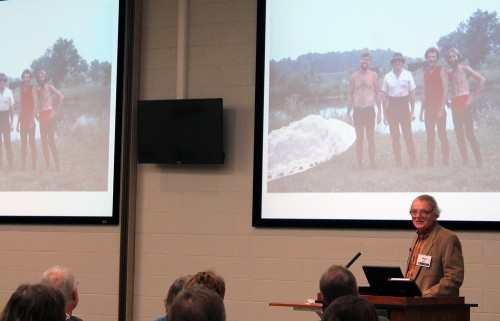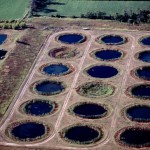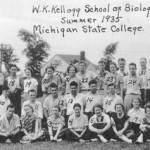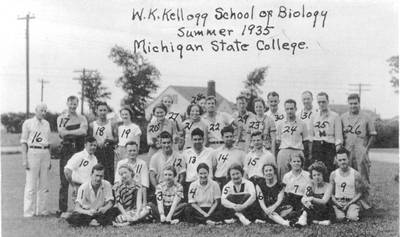Behind the greenhouse on the KBS Gull Lake site is a structure that contains a workshop and an adjacent series of storage garages. It was built in 1975, at a cost of a little over $40,000.
A workshop had been long needed at the Gull Lake site. At the time the workshop and garages were built there was already a workshop at the Physical Plant site on 40th street. The Physical Plant workshop was sometimes used by Art Wiest, a custodian based at the Gull Lake site whose work went well beyond what might commonly be thought of as custodial work. Graduate students also used the Physical Plant workshop to build their own research equipment. But that kind of use didn’t mix very well with the need of the Maintenance staff to manage its equipment and workspace for maximum efficiency. (These days we usually say “Physical Plant,” but back then everyone referred to it as “Maintenance.”) Mike Klug (KBS Director 1996-2003) remembers building some of his research equipment at home prior to the garages being built, due to the lack of a place at KBS to do the work.
Already back in 1958, it had been recognized that a workshop was needed. The 1958 proposal to the W.K. Kellogg Foundation that resulted in all of the “red brick” buildings on the KBS site, such as the Stack Research Building and the McCrary Auditorium and Cafeteria, had originally included a “student laboratory” that was to have been built next to the greenhouse. A workshop was to have been part of this building.
While the 1958 proposal was fully funded and all of the other buildings were completed, the student laboratory was never built. It may be that the capacity of the Stack Research Building was instead increased to handle some of the functions originally intended for the student laboratory. The Stack Research Building ended up serving as the main building for both research and classrooms, but in the end, there was still no workshop.
It wasn’t just the workshop portion of the building that was needed, though. In the 1970s, there was increased use of radioactive isotopes for biological field research. Robert Wetzel’s research program was making substantial use of carbon and phosphorous isotopes as radioactive tracers, as was the program of Mike Klug, a newer member of the faculty at the time. While these techniques were growing in use at research institutions across the country, proper protocols were often lacking. Universities saw the need to invest in better facilities for management of radioactive materials and for waste disposal. Since this was an important issue at the time, it was not difficult for KBS to obtain Michigan State University funds for a new garage and workshop facility. Klug assisted in designing the portion of the building where radioactive materials could be stored and accidental spills could be contained, complete with an alarm and Halon fire suppression system to rapidly extinguish any fire in the room.
The building also includes a series of storage garages, one for each of the faculty research programs at the time. Long before 1975 research programs had been overcrowding the Stack Research Building. There was little elbow room for working in laboratories, and the hallways were lined with cabinets and large items could not be accommodated in the laboratories and offices. While this made for a collegial environment where one always bumped into others, it wasn’t an efficient workspace. The garages helped to relieve some of the pressure, but the Stack Building was still very crowded. During this same time, George Lauff (KBS Director 1964-1991) was also at work garnering University support for two major grant proposals that ended up changing the appearance of KBS and did much to provide the present-day facilities.
The garages are a utilitarian building, not built in the “red brick” style that university architects had insisted be used for MSU structures back when the Stack Research Building was built in 1960. George Lauff wanted the new garages and workshop to be relatively inconspicuous and to blend with the old Tudor style of the nearby buildings built by W.K. Kellogg. So the building is nestled into the hill behind the greenhouse, and some Tudor styling can be seen on the gable ends.
Even though elbows have more room in the laboratories today, the building is still well used, as can be seen by the frequent foot traffic between the Academic/Stack building and the space behind the greenhouse.
(Thanks are due to Mike Klug and Mark Williams for providing information about this facility, and to Danielle Zoellner and Mike Klug for editorial comments.)





